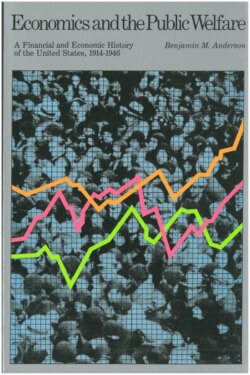Читать книгу Economics and the Public Welfare - Benjamin M. Anderson - Страница 19
На сайте Литреса книга снята с продажи.
Оглавление[print edition page 90]
9
The Rapid Revival—August 1921 to March 1923
The rally in business production and employment that started in August 1921 was soundly based on a drastic cleaning up of credit weakness, a drastic reduction in the costs of production, and the free play of private enterprise. It was not based on governmental policy designed to make business good. The drop in the physical volume of production from the high of July 1920 to the low of 1921 was drastic and was indeed unprecedented in severity, so far as records went, down to that date. The depression was, however, much less severe than that of the 1930s. This was primarily because of the very rapidity of the break in prices and the general readjustment in costs. On the basis of the Federal Reserve Index of Production (which has as its base the average for the years 1923-25) the physical volume of production dropped from 89 in July 1920 to 65 in July 1921. Then the Index of Production began to rise. Moderate improvement began in August 1921. Through 1922 there was strong improvement and by March 1923 the Index of Production had risen to the radical new high of 103, and it rose further to 106 in April 1923.
Little Helped by Outside World. It is noteworthy also that, so far as the outside world was concerned, conditions during this period of strong recovery were very discouraging. Throughout the world there had been the gravest kind of crisis and very deep depression. The tide turned in the United States without outside help. The turn in the United States was followed by a turn in certain other parts of the world—namely, in those countries which had kept closest to the gold standard and which had maintained the soundest public finances—notably England, the Scandinavian countries, Switzerland, and the Netherlands. But prolonged difficulties continued in Germany, in France, in Italy, in Belgium, and in Japan, to say nothing of Austria, Poland, the Balkans, and Latin America.
Break in Building Cost Starts Building Upward in Early 1921. The first sign of recovery in the United States came early in 1921 in the building trade, several months before the general upturn in production began.
[print edition page 91]
Building costs had risen to fantastic heights during the boom of 1919 and 1920. The Index of Construction, taking 1914 as a base, had been reduced to 64.9 in 1918, the second year of the war, had risen to 88.7 in 1919, but had dropped drastically to 48.5 in 1920. It rose to 91.8 in 1921, the rise beginning early in the year with the drop in building costs, and rose to very substantial volume in the latter part of the year. In 1922 it rose to 139.2. The Index of Construction and the Index of Production moved in opposite directions between 1920 and 1921. The volume of production dropped from 124.5 to 103.9 while the volume of construction was rising from 48.5 to 91.8. In 1922 the two indexes moved together again, construction reaching a new high with production approaching 1920 again. The table previously given (p. 39), showing the physical volume of production and construction for the years 1914-22 inclusive, is here repeated.
PHYSICAL VOLUME OF PRODUCTION AND CONSTRUCTION, 1914-22*
| Year | Total volume of production | Total volume of construction |
| 1914 | 100 | 100 |
| 1915 | 113.7 | 97.9 |
| 1916 | 120.6 | 111.3 |
| 1917 | 125.5 | 93.8 |
| 1918 | 124.5 | 64.9 |
| 1919 | 116.7 | 88.7 |
| 1920 | 124.5 | 48.5 |
| 1921 | 103.9 | 91.8 |
| 1922 | 121.6 | 139.2 |
* Frederick C. Mills, Economic Tendencies in the United States (New York, 1932), pp. 188, 191; bases changed from 1913 to 1914.
